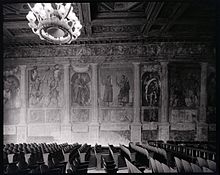
Padua is a city and commune in Veneto, northern Italy. Padua is on the river Bacchiglione, west of Venice. It is the capital of the province of Padua. It is also the economic and communications hub of the area. Padua's population is 214,000. The city is sometimes included, with Venice and Treviso, in the Padua-Treviso-Venice Metropolitan Area (PATREVE) which has a population of around 2,600,000.

The Doge's Palace is a palace built in Venetian Gothic style, and one of the main landmarks of the city of Venice in northern Italy. The palace was the residence of the Doge of Venice, the supreme authority of the former Republic of Venice. It was built in 1340 and extended and modified in the following centuries. It became a museum in 1923 and is one of the 11 museums run by the Fondazione Musei Civici di Venezia.
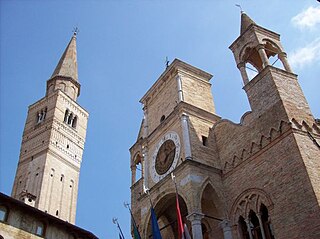
Pordenone is the main comune of Pordenone province of northeast Italy in the Friuli Venezia Giulia region.

The Palazzo della Ragione is a medieval market hall, town hall and palace of justice building in Padua, in the Veneto region of Italy. The upper floor was dedicated to the town and justice administration; while the ground floor still hosts the historical covered market of the city. The palace separates the two market squares of Piazza delle Erbe from Piazza dei Frutti. It is popularly called "il Salone" . It is part of the UNESCO World Heritage Site of Padua's 14th-century fresco cycles.

Hvar is a town and port on the island of Hvar, part of Split-Dalmatia County, Croatia. The municipality has a population of 4,251 (2011) while the town itself is inhabited by 3,771 people, making it the largest settlement on the island of Hvar. It is situated on a bay in the south coast of the island, opposite from the other nearby towns of Stari Grad and Jelsa.

The Orto Botanico di Padova is a botanical garden in Padua, in the northeastern part of Italy. Founded in 1545 by the Venetian Republic, it is the world's oldest academic botanical garden that is still in its original location. The garden – operated by the University of Padua and owned by the Italian government – encompasses roughly 22,000 square meters, and is known for its special collections and historical design.

The House of Carrara or Carraresi (da Carrara) was an important family of northern Italy in the 12th to 15th centuries. The family held the title of Lords of Padua from 1318 to 1405.

Padua Cathedral, or Basilica Cathedral of Saint Mary of the Assumption, is a Catholic church and minor basilica located on the east end of Piazza Duomo, adjacent to the bishop's palace in Padua, Veneto, Italy.

Stabiae was an ancient city situated near the modern town of Castellammare di Stabia and approximately 4.5 km southwest of Pompeii. Like Pompeii, and being only 16 km (9.9 mi) from Mount Vesuvius, this seaside resort was largely buried by tephra ash in 79 AD eruption of Mount Vesuvius, in this case at a shallower depth of up to 5 m.
The culture of Rome in Italy refers to the arts, high culture, language, religion, politics, libraries, cuisine, architecture and fashion in Rome, Italy. Rome was supposedly founded in 753 BC and ever since has been the capital of the Roman Empire, one of the main centres of Christianity, the home of the Roman Catholic Church and the seat of the Italian Republic. Due to its historical and social importance, Rome has been nicknamed the Caput Mundi, or "capital of the world".

Santa Sofia is the oldest Roman Catholic church structure in the city of Padua, region of Veneto, Italy. It was built in the 10th century on the site of a presumed Mithraeum. A grant was made to bishop Sinibaldo of this church in 1123, which had already been in construction. The Romanesque stone and brick facade was constructed from 1106 to 1127, but the semicircular apse may date from earlier. The interior is now relatively bare.
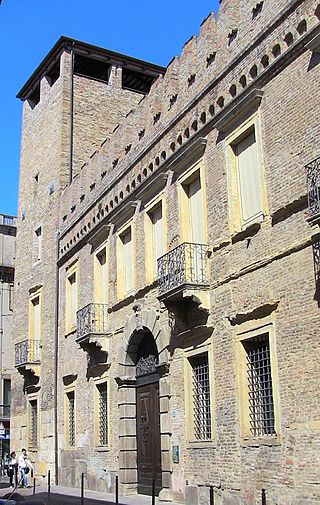
The Palazzo Zabarella is a medieval, fortress-like palace with a crenellated roof-line, and corner tower, located on Via San Francesco 27 in the center of Padua, Italy. The building now houses the Fondazione Bano, and serves as a locale for cultural events and exhibition.

Piazza dei Signori is a city square in Padua, region of Veneto, Italy. This piazza for centuries hosted official civic and government celebrations, while the larger squares of Piazza delle Erbe (herbs) and Piazza della Frutta (fruits) hosted commerce and public festive celebrations. The square is dominated by the famous Clock Tower.

Piazza delle Erbe is one of the many squares in the historic center of Padua. For centuries, with Piazza della Frutta, it was the commercial center of the city. In the two squares is one of the largest markets in Italy. Unlike Piazza dei Signori, the civic theater of celebrations, Piazza delle Erbe was the site of the folk festivities. The square is dominated by the imposing Palazzo della Ragione.
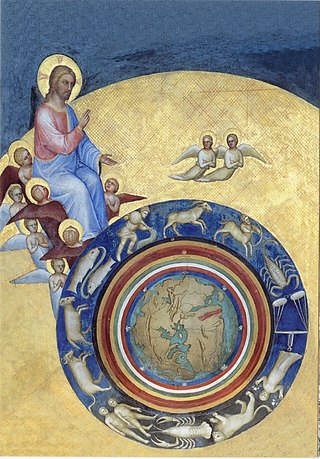
The Padua Baptistery, dedicated to St. John the Baptist, is a religious building found on the Piazza del Duomo next to the cathedral in Padua. Preserved inside is one of the most important fresco cycles of the 14th century, a masterpiece by Giusto de Menabuoi.
The following is a timeline of the history of the city of Padua in the Veneto region of Italy.
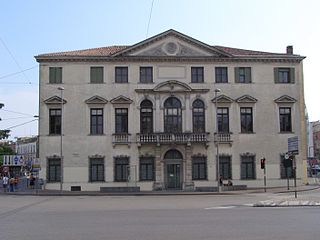
The Palazzo Cavalli alle Porte Contarine, also called the Palazzo Cavalli agli Eremitani is a Renaissance-style palace located at the intersection of Corso Giuseppe Garibaldi and Via Giacomo Matteotti in Padua, region of Veneto, Italy. In 2019, it is owned by the University of Padua and houses the university's collections of geology and paleontology in the Museo della Natura e dell’Uomo.

La Specola is a 14th-century tower, formerly part of a medieval castle, and converted in 1767 into an astronomical observatory (specula) in Padua, region of Veneto, Italy.

The bombing of Padua was a series of attacks by the United States Army Air Force and the Royal Air Force on the Italian city of Padua, Veneto, during World War II. These raids were aimed at disabling Padua's marshalling yard, but also resulted in heavy damage to the city and civilian casualties.

The House of Buzzaccarini is a Patavian family that had a notable role in the history of the Republic of Venice.
